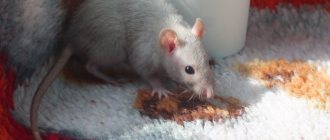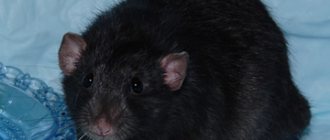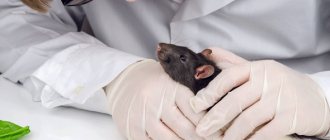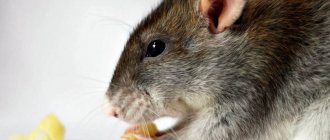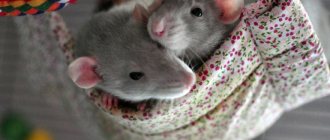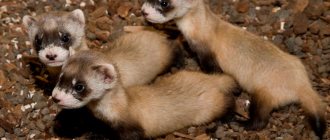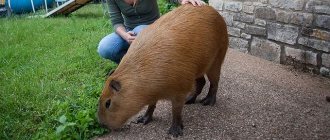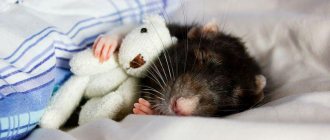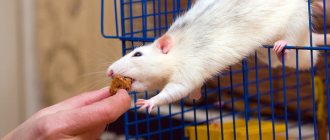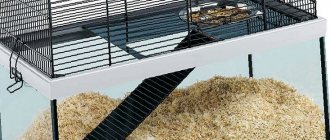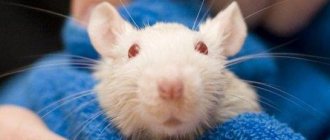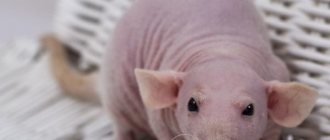When hearing the word “house rats,” many people feel disgusted and immediately imagine animals that run around yards, cause damage to property, and may well be carriers of diseases. But in reality, pets can be quite interesting. Science has proven that rodents are very smart, easy to train and extremely smart.
What should you consider when choosing a pet rat? The colors of the animal are varied. There are white, black, gray, orange, brown, blue, and beige pets that children like so much.
Description of the animal
Rats belong to the class of mammals. Body dimensions can be up to 30 cm and weight 300 - 400 g. Animals lead a terrestrial lifestyle. In nature, there are rats that can climb trees. They live in burrows alone or as a family.
In addition to wild rats, there are also affectionate, caring domestic pets. Currently, many interesting decorative individuals have been bred. They communicate very well with people.
Among them it is possible to meet a unique animal without hair - the sphinx or, conversely, curly-haired animals. A rat can be tailless or have a flat tail and ears of different shapes.
A very interesting specimen is the Dumbo rat, whose coat colors can be gray, white or black. And the advantage is the ears. The larger they are, the more valuable the specimen.
The color of a rat is an important criterion when choosing a pet.
In China, Ancient Egypt and Japan, these animals were revered as sacred animals and lived in temples. It was believed that they could predict events.
Which breed is better to choose?
Given such a variety of rat breeds, novice breeders often wonder what type of pet to buy. To make the right choice, you must be guided by the following criteria:
- Price . Among decorative rats there are both expensive and affordable breeds. If the financial situation does not allow you to pay a large sum for a rat, it is better to choose the classic option - the standard.
- Animal size . Breeders who prefer compact rodents should pay attention to varieties such as Dumbo or Manx. If large pets are in favor, the ideal option would be a standard or satin breed.
- Presence of allergic reactions to wool . An ideal option for allergy sufferers would be the Sphinx or Fuzz. Although the latter have fur, it is very short and practically does not grow. But it is better for breeders prone to allergies to avoid Double Rex and Pseudo-Sphinx rats - rodents of these breeds shed heavily.
- Appearance . Quite often, when choosing a decorative rat, buyers focus solely on appearance. The main thing here is to choose the animal that you like most.
- Lifespan . In general, rats do not live long - about 3 years. However, representatives of some breeds do not live to this age due to health problems, for example, rexes or sphinxes. Among the long-livers are Dumbo, Husky, and Fuzz.
- Unpretentiousness to living conditions . If you plan to purchase a rat that is not very sensitive to external conditions, it is better to purchase a standard or albino breed. Among the demanding rodents are sphinxes, fuzzes, and rexes.
The types and breeds of rats are amazing in their diversity. And each variety has its own characteristics, advantages and disadvantages. Therefore, before buying a pet you need to weigh the pros and cons. After all, a rat is not only a pet, but also a faithful friend for all family members.
Pets
Professionals know a considerable number of colors of rats. All of them in most cases appear in the form of various color combinations. Meanwhile, not all rodents meet the requirements of the standard. Nevertheless, owners of such rats can register them in the prescribed form and present them as an independent breed.
The most important thing is to focus on a limited number of relevant features. Worried about the color and color of the eyes, breeders often neglect to take care of the physique and well-being of the animal. As a result, many purebred rats, unlike wild rodents, are characterized by poor health and reduced vitality.
Every pet can be identified by color, markings and coat type. Some rat color names were taken from other representatives of the animal world, namely cats and dogs. For example: Siamese, Rex, Husky. Currently, the colors of rats are often found in completely different shades, which can be red, black, or silver. Siamese and Himalayan animals are found in large numbers.
Division of colors
Color is the color or shade of the fur of a decorative rat. Currently, there is a fairly large number of shades, and they are all divided into uniform, ticked and combined, silver and marked:
- Uniform colors are when all the hairs are the same color and tone. For example, black - the coat is black from root to tip. The undercoat is extremely dark. There may be other colors - blue, Russian blue, smoky blue.
- Ticked colors. Ticking is uneven hair coloring. In other words, there are zones on the wool that are colored in different colors. Among these non-standardly colored hairs, guard hairs of the same tone are identically interspersed. Agouti-colored rats are ticked.
- Silver color is absolutely any of the generally recognized colors. They can be uniform and ticked. Their main feature is the periodic repetition of silver and colored hairs in the same amount. All silver hair should be mostly white, although it is acceptable to have a colored tip. The skin of such an animal gives the impression of shine and sparkle. If few white hairs are observed, the color is not recognized as such. In order not to confuse the silver color with pearl, the silver color should be clearly expressed.
- Combined colors are a combination of several colors. All shades can participate, with the exception of white. Multicolor extends to the entire body of the rodent in accordance with the standard. This includes Siamese colors - Siamese and Himalayan.
- Marked - a combination of white and colored areas of the hair. And marking is a pattern that involves a certain combination of white and colored areas.
A direct relationship has been established between the color of the hair coat and the color of the eyes of the animal. The shade of the eyes directly depends on the color of the coat. Quite often, white rats have red or black eyes.
When breeding ornamental animals with certain qualities, it is imperative to take into account the laws of genetics. It must be borne in mind that color, coat texture and a number of other physical characteristics are inherited by rats according to the general, well-known law of heredity.
Character and nicknames
These rats are less active than their other relatives. They quickly get used to their owners and become tamed. This rodent can quickly get used to its name and return to its cage at the first call.
When choosing a name for your rat, try to make it sound and simple, because rodents do not tend to remember long words. Ideally, the name should contain consonants so that the animal can more easily perceive it by ear. For example, the female can be called Goldie, Bonya, Dina, Lala, Sonya or Ollie, and the male can be called Ballou, Winnie, Teddy, Pete, Shonya, Duck or Tosha.
After some time, the dam will learn to respond to the sound of your voice and will run towards you. If you plan to let him outside to run around, you will need to hand train him first before returning him to his crate. When training a rodent, remember that he is not a dog, so be patient.
Other colors of animals
Sometimes you can come across a completely unexpected color of an animal’s fur. They are given specific names. For example - hood color. This original color is the most common. It looks as if a dark “hood” covers the head, but the back and belly remain white. An animal with this color is born from two black parents.
New rare colors of rats are obtained as a result of mutation, completely unexpected for breeders.
Very rare, but still there are tricolored individuals. Numerous lovers of decorative rats know them under the name “mosaic”. They are considered especially valuable and rare. It is rare to find individuals with such an original color. With their specific color, they are similar to tortoiseshell cats. In addition to white, there may be spots of two other colors on the coat. It can be gray, red, or beige.
According to various sources, only two individuals of tri-colored rats are known.
Important Features
The breed was bred in California laboratories in 1991, and in the 2000s such creatures were brought to Russia from England.
If you are wondering how long do dumbo rats live, then know that these rodents have a lifespan of three years.
The breed grows up to 20 centimeters. Females weigh from 200 to 400 grams, and males from 250 to 500 grams.
Character and life expectancy
The character of Dumbo rats is very friendly; affectionate and trusting animals quickly get used to their owners, remember their nicknames and are easy to train.
Dumbo rats become very attached to their owners.
Young rodents of this breed are more active than their cousins, they enjoy fun and active play with people and other rodents, older animals like to lie on their owner's lap or sit on their shoulder. This breed is very clean, neat and well accustomed to the litter box.
The average life expectancy of rodents of this breed is 2-3 years.
The lifespan of Dumbo rats in a home directly depends on the quality of housing and food. With proper care, timely treatment of rat diseases and feeding a balanced diet consisting of protein and fat with the addition of greens, vegetables, fruits and vitamins, the life of pets is extended to 4-5 years.
Breeding history and appearance
Dumbo rats look very funny and touching because of their large and disproportionate ears with a small head, which makes many people emotional. This breed is especially loved by young children for its attractive appearance.
Dumbo with pointy ears
Dumb rats have two types of cute ears: flat, round, saucer-like ears, or slightly pointed, reminiscent of a half-open tulip bud with a curved petal, the pointiness is slightly pronounced.
When the latter ear variant is pressed from behind, the pinna opens and the regular rounded outline of the ear is visible, Dambo rats with this ear variant are widespread in European countries.
Dumbo with round ears
American scientists bred decorative dumbo rats in the laboratory in 1991 in California, but only 10 years later the charming rodents found their way to Russia.
Despite the popularity of pets with large ears, it is difficult to find rats with clear breed characteristics. The big ears gene is recessive, so it doesn't appear in every litter of rats, even if the parents have particularly large, round ears.
Animals with ears without identifying species are still considered ornamental dumbo rats and can produce adorable babies with adorable round ears.
The body length of animals of this breed does not deviate from standard parameters: males grow to 18-20 cm and weigh 250-500 g, females reach 15-18 cm and weigh 250-400 g.
These rodents have a more pear-shaped short body compared to ordinary decorative rats, and the lower part is more developed than that of the standard breed. The Dumbo breed can have a standard body type, like regular domestic rodents.
The dam's skull is flatter and wider than that of other ornamental rat species, with a relatively pointed snout. The forehead is slightly prominent, but not hunchbacked, and the eyes are large, round and located on both sides of the head. The Dumbo breed has a longer tail than the standard domestic rat.
Colors
Dumbo rat, amber in color. The color of this breed, as well as the length and quality of the coat, can vary greatly within the species. Individuals with short, velvety straight hair are most often found in grey, white, black and chocolate colors. Rare Dumbo rat colors are considered Siamese, Amber, Topaz and Mosaic (Tricolor).
Dumbo rat, tricolor
Incredibly beautiful blue mink rat-dumbo. Can be found only from large breeders, at a fairly high price for decorative rats.
Blue Mink Dumbo Rat
By crossing dam rodents with decorative rats of other breeds, scientists managed to obtain a new subspecies that deserves the attention of amateur breeders.
Dumbo rat, topaz color
The only tricolor beauty
The second tricolor rat was born in 2006 and received the original name - Dusty Mouse Shabu-Shabu. This is an amazing baby that violates all previously formed concepts about the genetics of rodents. Its uniqueness lies in the fact that the wool is dyed in three colors. According to the marking standard, this animal has a champagne hood color. The tri-colored Shabu-Shabu rat has a champagne-colored stripe along its back, head and shoulders, and the rest of the body is white. But in addition to these colors, black spots are also visible on this original. Theoretically, this is considered impossible.
More than 40 types of markings and colors are known to professionals involved in breeding and keeping rats.
However, there is not a single individual that combines exactly three colors. Shabu-Shabu Dust Mouse's parents were champagne and black hoods. Nothing similar was observed in other litters of these parents.
Recently, rare white rats with red eyes have been observed. These are albinos. This white color and eye color indicate that they have problems with melanin production.
Features of maintenance and care
If you are planning to buy a Rex rat, you will need to get equipment for breeding this animal:
- Spacious cage.
- Food bowls.
- Separate shelter house. It is better if it is made of hardwood.
- Swing.
- Hanging toys, hammock.
Your pet's cage should be cleaned weekly. Disinfect the cage once a month. It is very important for your pet to have a clean home and always have fresh water in it. You can pour it into a bowl or buy a boozer from a pet store.
It is better to feed the animal in the evening, but part of the daily ration can be given in the morning. The most common question about caring for frizzy rats (fly rats) is the specifics of their diet. Experts recommend taking ready-made formulas as the basis of a rex's diet. It is necessary to add vitamins, grains, fruits, and herbs to them. A rat eats 15-20 g of food per day.
If the rodent's diet consists mainly of natural food, it should include:
- semi-finished products;
- fresh apples;
- leaf salad;
- pieces of boiled chicken meat;
- boiled eggs;
- seeds;
- sour cream;
- kefir;
- fruits and dried fruits.
Important: You can treat your pet with unsweetened breadcrumbs from time to time, especially during training.
Cute animals that look like cats
Quite recently, a rat with an interesting color was bred - Siamese. The color of this variation is very similar to the color of a Siamese cat. There is a black mask on the muzzle.
Siamese rats have a light beige coat throughout their body. The beginning of darkening is noted closer to the tail. In the front of the head, in the area of the nose and paws, they are black. There is an opinion that the darker the color, the more “pedigreed” the rat looks. Siamese pets almost always have pink eyes. However, more recently, Siamese rats with black eyes have appeared. As it turns out, a large number of animal lovers prefer individuals with dark eyes.
Regular colored pet
The variety of shades represents the agouti color. The impeccable beauty of this suit wins the hearts of even harsh experts. Agouti is a “wild” color. In the reference book it is presented as gray, but is actually red-black.
These are the ones that are kept at home in most cases. The agouti rat has golden fur. Most individuals have a dark back and a light yellow or white belly. Sometimes there may be a hint of orange in the color. This is because the rat has a shiny coat. The lifespan of agouti at home can be up to 20 years.
A rat with a color like a four-legged friend
People who hear the word “husky” immediately think that we are talking about sled dogs. However, in nature there are other animals with this name. These are domestic decorative rats.
The variety of the animal is very interesting, with different properties. The Husky rat gets its name due to the similarity in color to this breed of sled dog. Unlike other varieties, they can change coat color. Cubs are born with a normal color. May also be black.
Their markings may be similar to banded. This means that the colored spots are located on the body or body of the rat, which is dark in color, as if covered with a cloak, and the tummy is white.
But over time, as the animal grows up, the baby fluff changes to adult fur, and white hairs appear in the color. This dilution with white occurs throughout life. Over time, the original color fades to white. This is how the rat changes color.
The ideal color for a husky is salt and pepper. There is a white spot on the rat's face that resembles the spots on the faces of dogs. It has an inverted V-shape and is called "blaze".
It is because of this feature that the animal was given such a name.
Main differences between the species
Rats are classified into separate breeds based on the presence of certain criteria characteristic only for a particular species. The main distinguishing features are:
- Body type. The classic option is considered standard. Representatives of this species are distinguished by their average body size - up to 25 cm from the tip of the nose to the tip of the tail, rounded, high-set ears, and large eyes. In general, pets look proportional and graceful. Boys are larger than girls. The next type is dumbo. The main distinguishing feature is small round ears set on the sides of the head. Pointed ears are also considered a variant of the norm, but only slightly. Another body type is tailless. The name speaks for itself; the animals do not have a tail.
- Coat type. Standard – medium-length shiny coat evenly covering the body. Only the toes and tail are covered with barely noticeable fluff. Curly – pets are distinguished by curled mustaches and a curly coat, slightly straighter on the stomach. Wavy – thick coat with developed undercoat. The fur of both sexes is soft to the touch. Vibrises are distinguished by barely curled tips. Downy – the rat’s body is evenly covered with dense short fluff, reminiscent of corduroy to the touch. The fur on the face may be slightly longer. The Sphynx has no fur at all. A minimum amount of hair is allowed on the muzzle and in the groin area. Long-haired - the animal is covered with thick, long hairs that are soft to the touch.
- Color. Among decorative rats you can find a pet of a wide variety of colors - plain, targeted, combined, silver, even tricolor.
Different breeds of rats differ not only in appearance, but also in character and temperament. Some breeds lead a sedate lifestyle. Others, on the contrary, prefer active recreation.
Markings for this color
A husky rat can only be one of two available markings:
- Berkshire Husky.
- Banded Husky.
The Berkshire Husky is a coat type marking with a white belly and colored rat back. The head, like the back, is also colored.
Banded Husky is a "hood" type marking where the animal's head, chest and shoulders are evenly colored. The exception is Blaze. From the so-called hood, a strip of dyed wool runs along the back. In this marking, such a stripe is very wide.
Beautiful blue rats
This amazingly beautiful animal deserves special attention. Among the large number of ornamental animals, the blue rat is considered an aristocrat. The animal's fur to the base and undercoat have a blue tint. The belly can have a different color: white or gray, a blue tone is possible.
This rat has very beautiful glossy fur. Loneliness is undesirable for her. She doesn't tolerate it well. That's why they are brought up in pairs. But if there is no desire to have several such animals, then you will have to pay more attention to this one existing pet. During the day, one hour of communication with a person is enough for them.
Vaccination
Decorative rats do not need vaccination. No drugs have been developed for them to help prevent the development of diseases in these animals.
Selection and accessories for your pet
An animal's cell must contain several elements:
- drinking bowl;
- feeder;
- nest (place to sleep);
- a mineral stone on which the animal will grind its teeth.
To prevent the animal from getting bored, toys are placed in the house. Rats are very fond of such a device as a hammock. It can be made from a piece of durable fabric or purchased ready-made at a pet store.
Most preferred toys:
- ladders, including rope ones;
- tunnels;
- labyrinths.
Predators in nature
As a rule, in urban areas you can most often find ordinary rats. They may have a gray, sometimes black skin color. The colors of rats in nature range from grayish to red. Sometimes you can find a brown rodent.
The most common types of rat colors in nature:
- Gray rat. Young animals have gray fur. When they mature, they acquire a reddish tint. On the abdomen, white hairs have a dark base.
- Black rat. On the back, the color of the skin has a greenish tint. The belly has dark gray or ash-colored hairs.
- Small rat. It has a brown skin color.
In central Russia, there are mostly two types of rats: black and gray.
